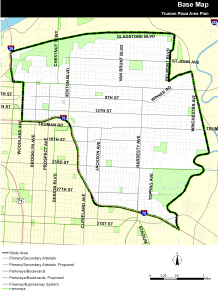
By Leslie Collins
Northeast News
March 23, 2011
Truman Plaza Area Plan is about vision and the City of Kansas City is asking for public input.
“The purpose is to gather the community’s ideals for where they want to see the community move over the next 10 to 15 years,” said Randy Dunn, city planner with the Kansas City Planning and Development Department.
“It gives us a road map of where to go in the future, what needs to be done and how that should happen,” added City Planner Kellie Johnston.
Kansas City is broken down into 18 geographical areas, Johnston said, and Kansas City is currently kicking off three plans, including Truman Plaza.
Truman Plaza’s plan will focus on five areas: infrastructure, transportation issues, land use, housing issues and crime. In addition, the plan will serve as a plan of record that specifies how land may be used and developed in the future. Having a plan also helps in applying for grants, Johnston said.
The plan’s boundaries include: Union Pacific (UP) Railroad Tracks; Independence Avenue between The Paseo and Woodland Avenue; I-70 east of Woodland Avenue to the Big Blue River; Chouteau Trafficway between UP Railroad Tracks (north) and the UP and Burlington Northern Santa Fe (BNSF) Railroad Tracks; the UP and BNSF Railroad Tracks between Chouteau Trafficway and the Big Blue River; the Big Blue River between the UP and BNSF Railroad Tracks and I-70; I-35 to The Paseo between UP Railroad Tracks and Independence Avenue; Woodland Avenue between Independence Avenue and I-70.
Dunn said the Truman Plaza plan is in the beginning stages and the first public meeting is tentatively scheduled for Thursday, April 21, from 6 p.m. to 7:30 p.m. at the North-East Public Library, 6000 Wilson Rd.
“Something new we’re doing is we’re having online town hall meetings,” Johnston said. “It’s a new approach that I think maybe a handful of cities have tried. So, we’re excited about it.”
The online town hall meetings is a website that directs users to a comment page that will address land use, transportation, economic development, housing and neighborhoods, urban design and community character.
“There will be general questions about each of those topics and then people can go online and post their ideas or recommendations for the area,” she said.
Users can also comment on other user’s comments, she said.
“I think it’s a great opportunity to be able to reach out to the population that typically doesn’t come to the public meetings,” Dunn said. “It’s an opportunity to reach out to them, get their input and make sure we’re being as holistic as possible in our outreach for the plan.”
Public comment opens March 28 and the online town hall meetings can be accessed at www.plankcmo.com. More information will also be available by searching “Truman Plaza Area Plan” on the city’s website www.kcmo.org.
Something else unique to the plan, Dunn said, is the incorporation of input from high school students at Northeast High School and East High School.
“I think that’s a voice that is often not heard in the planning process and when we’re talking about planning for 10 or 15 years in the future, these are the people that are likely going to be living here,” Dunn said. “We want to make sure we create a community that’s conducive to their desires, their wants and their needs.”
Dunn and Johnston will also meet with college students at Penn Valley Community College and Pioneer Community College.
The final plan will incorporate both the desires and comments from the community, along with those of the applicable city departments, Johnston said.
“We have to manage expectations. We’re not going to have a Disney World and those sort of things,” Dunn said. “We have to be realistic in terms of the recommendations we make, but we want to really be progressive in the ideas we put into the plan.”
Asked about the timeline for the Truman Plaza plan, Johnston said the city will host public meetings in April and May and write the plan in June. Another public meeting will be held in July and by early fall, the plan will hopefully be completed, Johnston said.
“We really encourage people to come to the meetings and to really give their input because this ultimately is their community’s plan,” Dunn said. “This is not Kelly and I sitting here saying, ‘This is what we think should happen.’ We need the community to come out and give us their ideas and input, so it can really be the community’s plan.”















